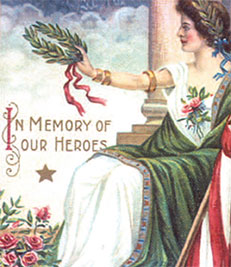“Nor Shall their story be forgot,
While Fame her record keeps.”
These lines from a stanza of an old 19th-century poem, The Bivouac of the Dead by Theodore O’Hara, are found on several Memorial Day postcards, including some by Raphal Tuck & Sons and International Art Publishing Company. Borrowings were also made from other patriotic poetry and national anthems for use as captions. Such cards were used by people nearly a century ago to help commemorate a very special day each year.
Several generations ago, in the years from the beginning of the 20th century to the advent of World War I, Americans celebrated patriotic holidays with great fervor and intensity. One important custom of those long ago days was the mailing of souvenir postcards to friends and relatives. Many such exchanges were lovingly saved for years to come, often being displayed in family albums and considered special keepsakes.
Card racks in the nation’s five-and-dimes, neighborhood variety stores, and specialized postcard shops abounded with general purpose patriotic cards year-round. Specific holidays, however, like the 4th of July and Lincoln’s Birthday, were responsible for not only the most beautiful and artistic cards imaginable, but for the greatest variety, as well.
Memorial Day, or “Decoration Day” as it was then called, was another national celebration commemorated by large numbers of postcards, though the tone here was far more solemn and respective than it was boisterous and jubilant.
Observed for the first time in 1868 by a still war-weary nation, Memorial Day soon became an annual May 30th tradition everywhere in the country; everywhere, that is, except in the states of the Old South. There a preference for special days and traditions to honor fallen Confederate heroes prevailed.
Not until after World War I, when the anger and distrust caused by the Civil War and the Reconstruction era that followed began to burn itself out, did anything resembling a national Memorial Day emerge honoring not only Civil War veterans but also those of subsequent wars.
To satisfy the public’s demand for special holiday issues, dozens of publishing houses, mostly located in the Northeast but including a few in Europe, turned out millions of Memorial Day postcards. These had artist-designed scenes depicting aged Northern veterans and women and children paying homage to the living and dead who had fought to preserve the Union.
Others portrayed soldiers of various wars marching off to battle and leaving tearful sweethearts and wives behind, as well as American flags, eagles, cannon, G.A.R. medals, and decorated graves. The color blue, Johnny Yank’s standard, dominates the artwork.
In all, nearly two dozen publishers produced more than 40 quality sets of six, eight, ten or twelve postcards each. In addition, a few singles were also marketed.
Though Memorial Day postcards date back as far as 1905, the most important years were from 1906 to 1914. Two American companies, E. Nash and International Art, and onforeign, Raphael Tuck & Sons, each created six sets over that span of time.
Nash, which began business operations in 1905, numbered its sets from one to six, and unlike the firm’s Halloween line of repeated designs, all 36 Memorial Day postcards had different illustrations. A rare attempt to break away from the often used Civil War theme occurred in Series Number 3.
One of the pictures depicts soldiers from five wars, including the Mexican campaign of 1848 and the Spanish-American War. Series Number 6 is likewise interesting. Each card shows a woman symbolizing the American nation, with flags, swords and other reminders of the conflict evoking the spirit of remembrance and sacrifice.
Tuck, arguably the greatest and most prolific paper novelty and ephemera publisher of all time, distributed postcards and other merchandise in this country through its American branch in New York City. Their first Memorial Day cards arrived in 1908 and included not only one set (Series Number 107) of 12 cards for sale in the North, but also a 12-card Confederate theme set intended for marketing in the South.
During the next three years, Tuck produced Series Number 158 (12 cards) in 1909; Series Number 173 (12 cards) in 1910; and Series Number 179 (10 cards), noteworthy for its multiple portrayals of General Ulysses S. Grant, in 1911. Another set for sale below the Mason-Dixon Line was Series Number 2510, “Heroes of the South.” This last set may well have also been sold by postcard specialty stores throughout the country.
The identify of the Tuck artists who created such sentimental and nostalgic scenes of ancient veterans, grateful citizens laying flowers on flag-decorated graves, children sweetly kissing the blue-clad heroes, and patriotism – as embodied by Old Glory, silent cannons, and G.A.R. mementos – are unfortunately unknown to us. A couple of sets, however, have long been credited to Frances Brundage, a popular artist of the day.
Gabriel & Sons, whose founder, George Gabriel, had once headed up Tuck’s American branch office brought out a beautiful ten-card set (Series Number 150) with gold borders. These are delightful illustrations of grandfatherly-looking veterans in their uniforms with children companions. Cards in this set contain some of the most passionate and patriotic verses to be found on any Memorial Day postcard.
Other important publishers for the holiday include L. R. Conwell Co., A.S.B (Series Number 283), Santaway (Series Number 157), and M. W. Taggart. A small number of unidentified firms were also involved
Of all wars, the civil War was the most traumatic for the American psyche and soul. Nearly a half-century after its ending, memories of the conflict, along with the hundreds of thousands of surviving veterans, influenced American social, economic and political life. This feeling is portrayed by another caption often found on Memorial Day souvenir postcards – “Lest We Forget.” The soldiers who fought and survived never forgot their comrades and friends, nor did their families ever forget fathers, sons, brothers and sweethearts who never came marching home at war’s end.
















Follow Us